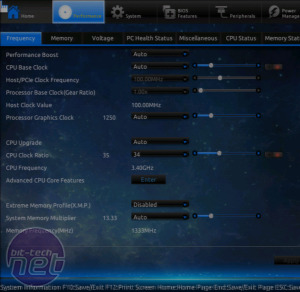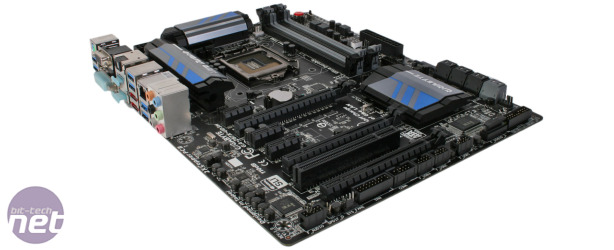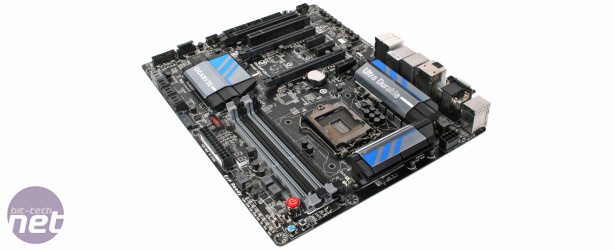Overclocking
While it ticks all the boxes feature and layout wise, the UD3H’s EFI BIOS feels a little overloaded, thanks in part to the replication of many menu options. The home screen can be switched between a performance tab, a standard tab, or four custom tabs made up of user-selected menus and settings, but all the same settings are elsewhere also grouped into more recognisable sub-categories of frequency, voltage, memory and more. Gigabyte has also chosen to use drop down menus and sliders to adjust settings, the latter a particularly odd choice as slider bars typically don’t offer the degree of accuracy and control you want when overclocking a board.

Click to enlarge - the EFI BIOS is heavy on drop down menus and slider bars, but repeats a number of settings across multiple menus
Regardless of its foibles though, all the settings and controls are there (and can be grouped to preference), making overclocking as straight-forward as upping the voltage and multiplier. Our Intel Core i7-4770K typically thermal-caps at 4.7GHz (47 x 100), and we had no issue hitting it, booting and benchmarking with a 1.26V Vcore. We were also pleased to find the board ran a little cooler than some of its competition and while still close to the 100° TJMax, hovered around the 95°C-96°C mark instead of 98°C-99°C we’ve seen with other boards at this frequency. This was despite the board consuming 205W system power under load – wherever the extra heat is going, it’s certainly not into the CPU heat spreader.
Performance Analysis
While it’s not the quickest Z87 board we’ve tested, the UD3H still accounts well for itself. At stock it managed an overall score of 2,475 points across our trio of Media Benchmarks, finding itself just a single point behind the Asus Maximus VI Extreme thanks to a strong score of 3,690 points in the video encoding benchmark. 3D performance was good at stock too, with a minimum frame rate of 93fps in Skyrim 2fps faster than the Maximus VI Extreme but 4fps slower than the Maximus VI Hero. A minimum frame rate of 29fps trumped the rest of the competition though, albeit by a single frame per second.With the core frequency at 4.7GHz the UD3H again produced a good display, with scores of 2,452 in the Image Editing test, 4,288 in the Video Encoding test and 1,714 in the Multi-tasking test. The latter two were a few per cent slower than the quickest Z87 boards we've tested, producing an overall score of 2,818, a result that’s actually a little slower than Intel’s own DZ87KLT-75K. However, the spread is very tight, with just 100 points (three per cent) separating the Maximus VI Extreme and the UD3H.
If the UD3H was a little slow at stock in our media benchmarks, it made up for it in our 3D tests. A minimum frame rate of 107fps in Skyrim is an equal best-result from a Z87 motherboard, while a minimum frame rate of 36fps in Shogun 2 again equalled the best result we’ve yet seen.
SATA 6Gbps speeds were solid too, with a peak sequential read speed of 534MB/sec and peak sequential write of 508MB/sec from our OCZ vector 256GB test SSD. Speeds were, as expected, much slower via the Marvell controller, topping out at 371MB/sec read and 243MB/sec write – just as well gigabyte colour coded the Marvell slots making them easy to avoid.
Power consumption was good too. At idle in particular the UD3H consumed less power than the competition, with system power as low as 60W when idle at stock. Overclocked the board did consume more power than its competitors, with a peak load system power draw of 205W, but we didn’t experience any thermal issues with the CPU, VRMs or Southbridge.
Conclusion
The Gigabyte GA-Z87X-UD3H strikes a great balance of useful, practical features, easy overclocking and a fair £149 price. While it’s not perfect, with the EFI repeating settings and a rather drab colour scheme, it nails the fundamentals so well that these flaws are easy to overlook. Extras such as on-board power, reset and clear CMOS buttons, in addition to an LED POST-code reader are easily worth the £20-£30 premium over cheaper boards, while dearer models and their heavy feature sets will likely only appeal to high-end niches - the vast majority don't need LN2 overclocking-ready gear, as impressive as it might be.In short, the GA-Z87X-UD3H is a Z87 board for the rest of us, providing almost everything a PC enthusiast or home overclocker needs, with none of the fluff, and at a competitive price.

-
Performance42 / 45
-
Features24 / 30
-
Value22 / 25


MSI MPG Velox 100R Chassis Review
October 14 2021 | 15:04











Want to comment? Please log in.